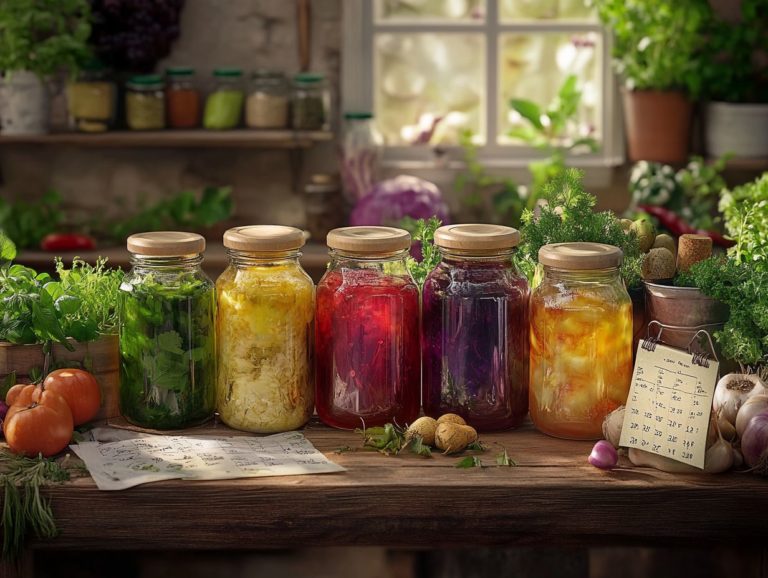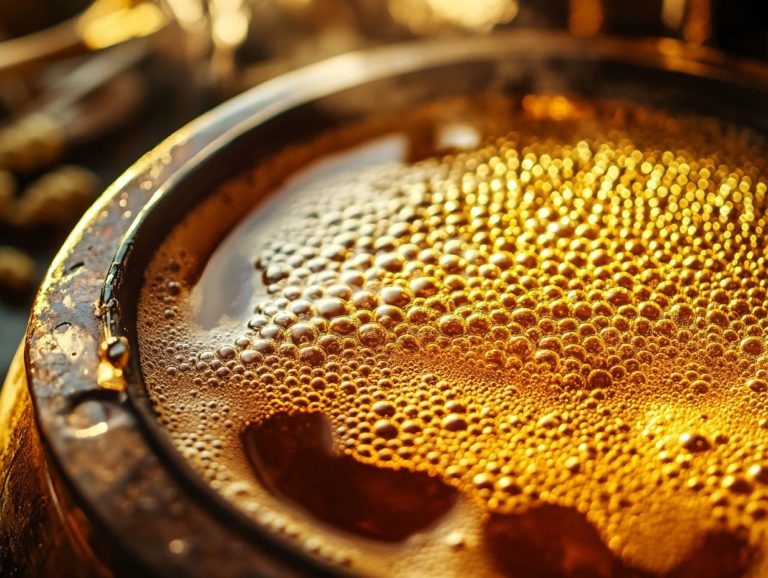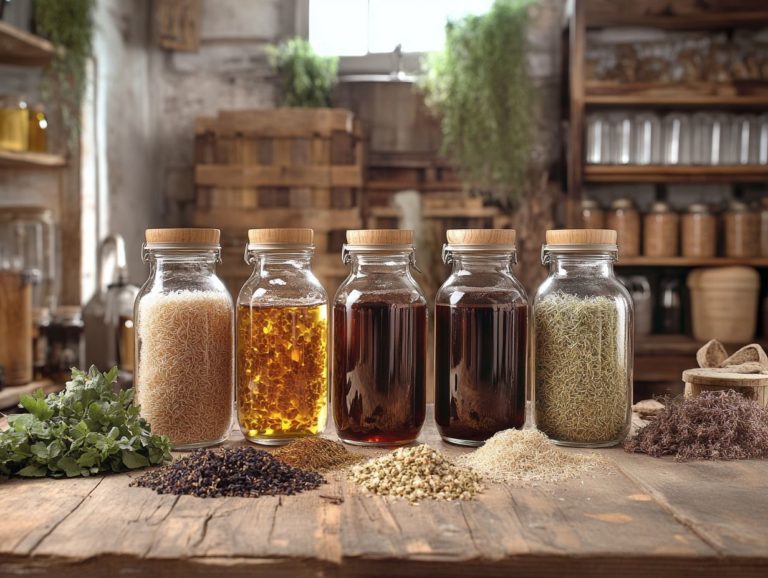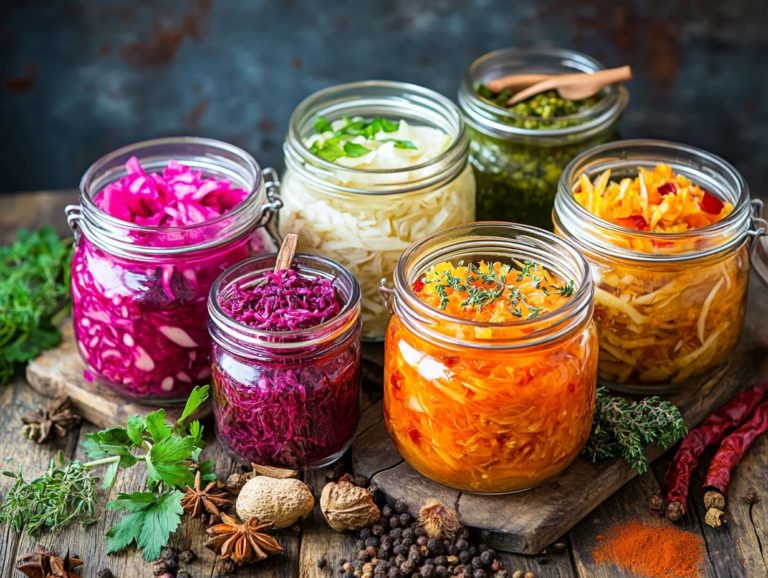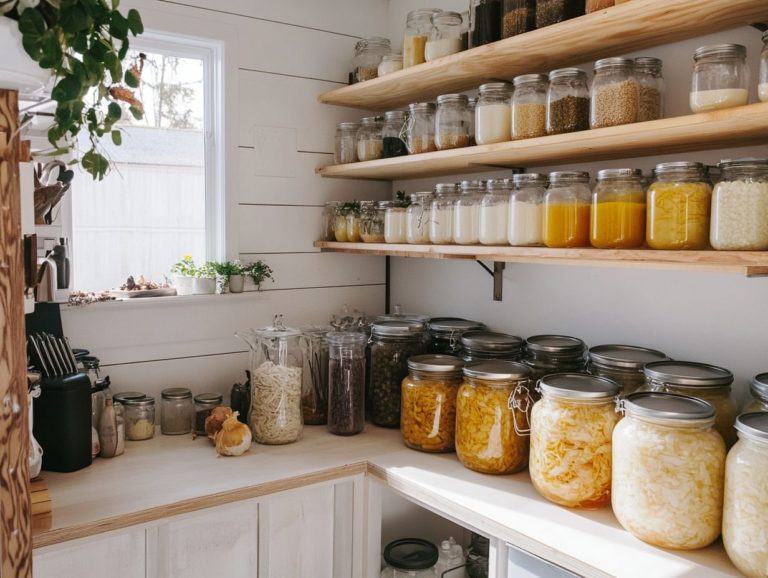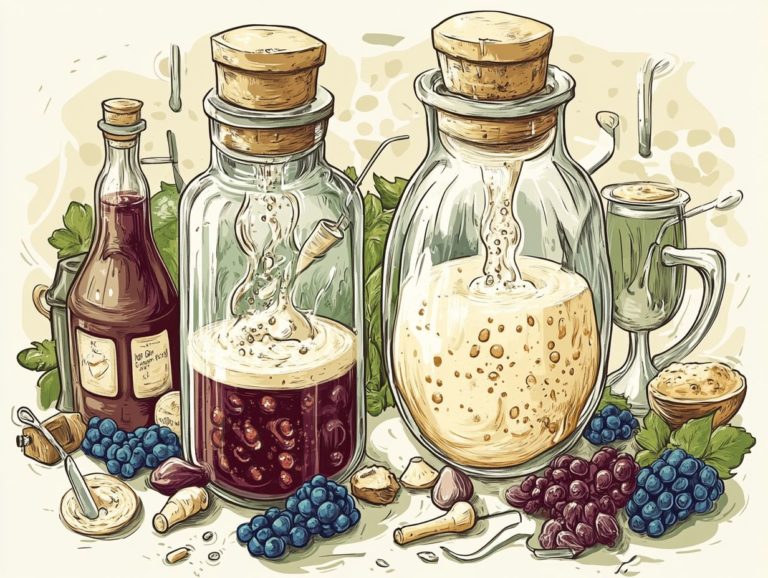Fermentation and Its Role in Craft Beer Culture
Fermentation is a captivating and vital process that transforms simple ingredients like cereal starch and proteinaceous substances into the rich flavors and aromas that characterize beer.
As you delve into the science behind yeast, including nitrogen and yeast nutrition, and explore the various fermentation methods employed in brewing, this article guides you through the intricate world of fermentation in beer-making.
Prepare to be amazed as you uncover the magic of fermentation and appreciate its crucial role in crafting unforgettable brews, understanding its historical significance and health benefits.
Contents
- Key Takeaways:
- What Is Fermentation?
- How Is Fermentation Used in Brewing Beer?
- What Are the Different Types of Beer Fermentation?
- How Does Fermentation Affect the Flavor of Beer?
- What Is the Role of Fermentation in Craft Beer Culture?
- 3. Role of Fermentation in Creating Experimental and Specialty Beers
- How Can Homebrewers Incorporate Fermentation Techniques into Their Beer?
- 1. Experimenting with Different Yeast Strains
- 2. Adding Fruits, Spices, and Other Ingredients During Fermentation
- Frequently Asked Questions
- What is fermentation and how does it play a role in craft beer culture?
- What are the different types of fermentation used in craft beer brewing?
- How long does the fermentation process typically take in craft beer brewing?
- What role does yeast play in fermentation and craft beer culture?
- What factors can affect the fermentation process in craft beer brewing?
- What is the significance of fermentation and brewing methods in the overall taste of craft beer?
Key Takeaways:
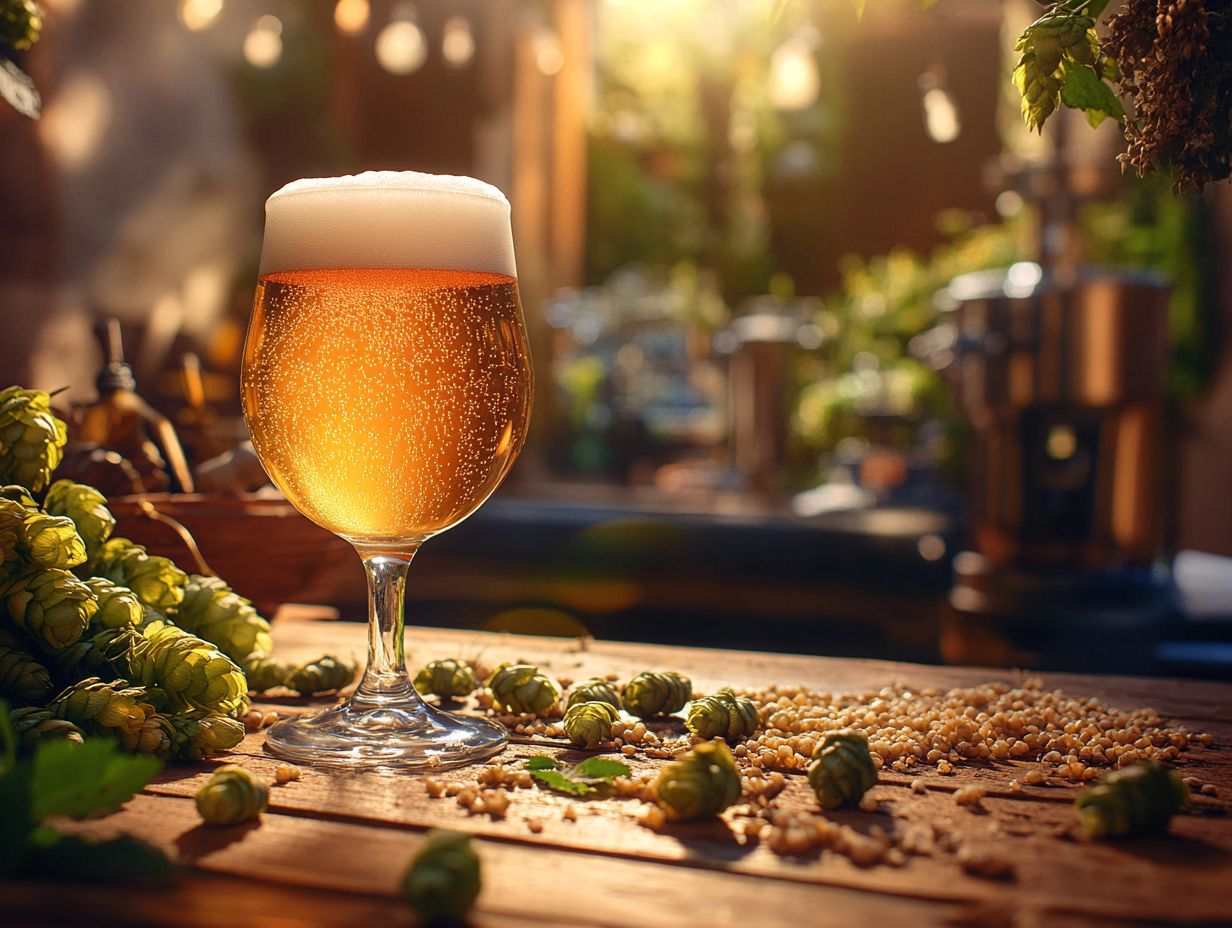
- Fermentation converts sugars into alcohol and carbon dioxide, creating beer.
- The choice of yeast and fermentation conditions significantly affect beer flavor.
- Craft beer culture thrives on unique fermentation techniques and ingredients.
What Is Fermentation?
Fermentation is a fascinating biological process where microorganisms like yeast and bacteria transform sugars into alcohol and carbon dioxide. This transformation leads to a delightful array of fermented foods and beverages, including beer, with significant contributions from brewing science.
For thousands of years, societies have embraced this ancient technique, not just for its rich flavors but also for the notable health benefits tied to fermented products. While the primary fermentation phase is essential, don t overlook the magic of secondary fermentation, which further elevates the final product’s characteristics.
Influential figures such as Louis Pasteur, Emil Hansen, and Robert Koch have significantly advanced our understanding of fermentation, laying the groundwork for the modern brewing practices you enjoy today.
1. Definition of Fermentation
Fermentation is the remarkable metabolic process where microorganisms, primarily yeast, transform sugars into alcohol and carbon dioxide in the absence of oxygen.
This intricate biological dance unfolds when specific microorganisms, such as Saccharomyces cerevisiae, a common type of yeast used in brewing, break down complex carbohydrates, effectively harnessing the available sugars as their energy source.
During this fascinating process, enzymes generated by the yeast facilitate the fermentation pathway, culminating in the production of ethanol and the release of carbon dioxide. The type and concentration of sugars present are pivotal, influencing not only the efficiency of fermentation but also shaping the flavors and aromas of the final product.
By looking into these biochemical interactions, you gain invaluable insights into a variety of fermentation applications, from brewing exquisite beers to crafting fine wines and producing artisanal sourdough bread.
2. Types of Fermentation
There are several fascinating types of fermentation you should explore, including alcoholic fermentation, where yeast converts sugars into alcohol, and lactic acid fermentation, which is primarily used in dairy products.
These processes serve distinct purposes and yield a variety of delicious end products, enriching your culinary adventures. In alcoholic fermentation, which plays a pivotal role in crafting beverages like beer and wine, yeast transforms sugars derived from grains and fruits.
On the other hand, lactic acid fermentation is essential for creating not only yogurt and cheese but also fermented vegetables like sauerkraut.
Grasping the nuances between primary fermentation which is where the initial metabolic activity occurs and secondary fermentation, which enhances flavors and aromas, is crucial for anyone eager to delve into the captivating world of fermentation.
We encourage you to try brewing your beer or experimenting with fermentation at home to experience the magic for yourself!
How Is Fermentation Used in Brewing Beer?
Get ready to explore the fascinating world of fermentation, the magic behind your favorite beer! Fermentation is an essential element in the art of brewing beer, transforming wort derived from malted barley and other grains into the delightful alcoholic beverage you savor.
At the heart of this process is yeast, particularly strains like Saccharomyces cerevisiae, which ferments the sugars present in the wort, generating both alcohol and carbon dioxide, contributing to the wort composition’s transformation.
The brewing techniques you choose, including the containers used for fermentation and the conditions you control, play a significant role in shaping the flavor characteristics and overall profile of the final product, influenced by both the brewing yeast and the brewing knowledge applied.
By grasping the science behind fermentation, you enable yourself to innovate and craft a variety of beer styles that appeal to a spectrum of tastes.
1. Role of Yeast in Fermentation
Yeast, especially Saccharomyces cerevisiae, is essential to the fermentation process in beer production. It serves as the primary microorganism, expertly converting sugars into alcohol and carbon dioxide, which are crucial in carbon dioxide production.
This remarkable organism is the cornerstone of brewing, with various strains that shape the character of the beer you enjoy. Each distinct yeast strain contributes unique flavors and aromas, adding complexity and depth to the final product. For example, some strains might impart fruity esters, while others generate spicy phenols, each significantly influencing your sensory experience of the brew.
Managing yeast effectively is crucial and includes temperature control, oxygen levels, as well as bacterial control and yeast nutrition. These factors directly impact fermentation speed and the overall flavor profile. By carefully regulating these elements, you can fine-tune your recipes, ensuring a consistent and delightful tasting experience every time.
2. Process of Fermentation in Beer Brewing
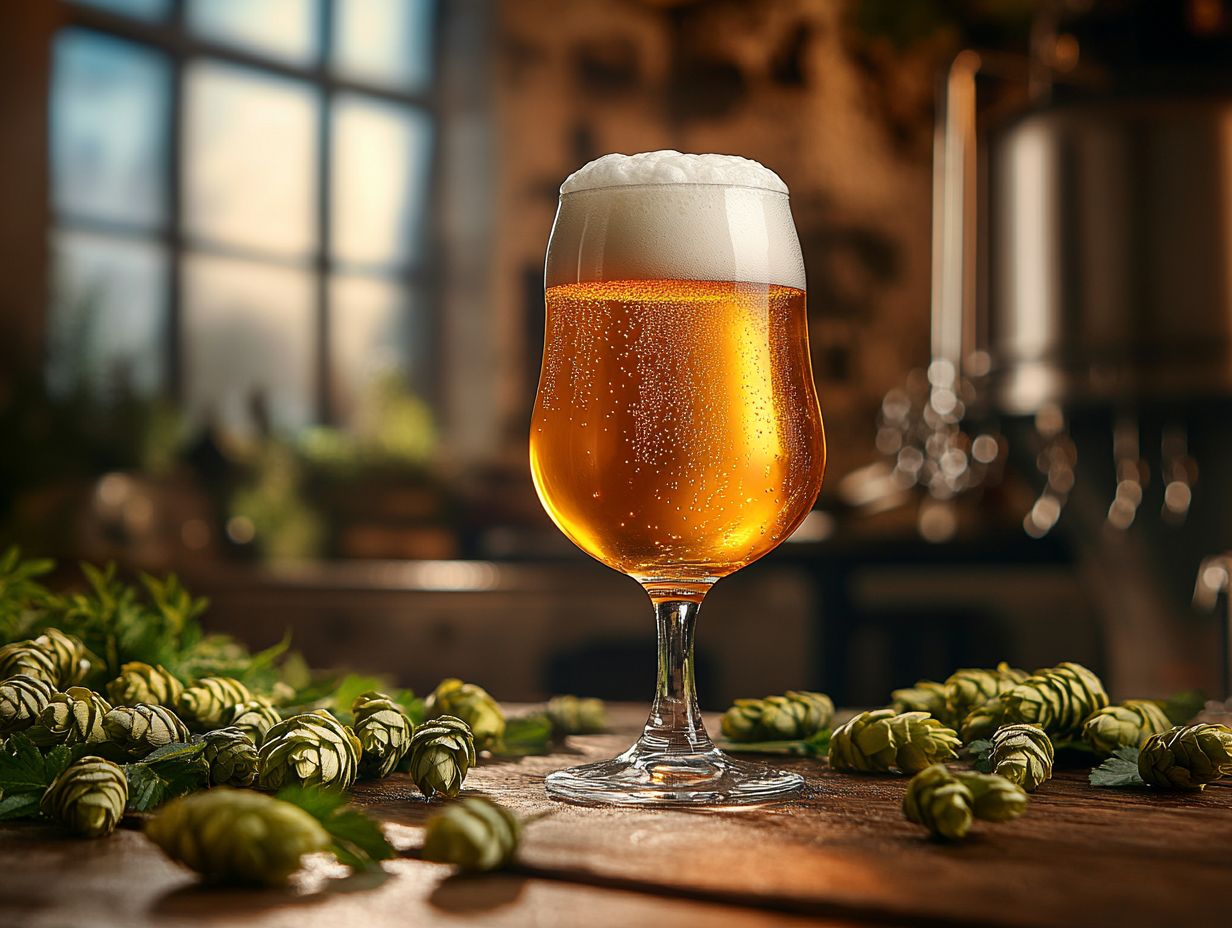
The brewing process is a fascinating journey, transforming wort the liquid extracted from malted barley into beer through a meticulously monitored fermentation process under controlled conditions.
It all starts with the preparation of the wort. Here, you mash the malt to release those vital fermentable sugars, then bring it to a boil with hops that elevate the flavor and aroma to new heights. Once that mixture cools down, it’s time to introduce yeast to the wort, kicking off fermentation in a vessel designed to create the perfect environment.
Keeping an eye on the right fermentation conditions like oxygen levels and cleanliness is essential, as these factors significantly influence yeast growth and the beer’s flavor profile, which are critical elements of fermentation technology.
Monitoring the temperature during this phase is crucial; higher temperatures can invite unwanted esters and fusel alcohols, which can impart harsh flavors while low temperatures can put the brakes on fermentation altogether. Act fast to maintain optimal temperatures! Don t underestimate the importance of time either; it plays a pivotal role in determining your beer’s clarity and taste. Patience is key here; ensure your beer achieves the desired quality and complexity!
What Are the Different Types of Beer Fermentation?
Beer fermentation can be divided into two main types, depending on the yeast strains employed: top-fermenting yeast, which is primarily used in ale production, and bottom-fermenting yeast, typically found in lager brewing.
These fermentation methods not only influence the brewing process but also play a pivotal role in defining the flavor and aroma profiles of the various beer styles. The selection of yeast strain is paramount, as it dictates the fermentation temperature and duration, ultimately molding the characteristics of the final product, showcasing the advantages of fermentation.
1. Top-fermenting Yeast (Ale)
Top-fermenting yeast is the star player in ale production. It thrives at warmer temperatures and rises to the top of the fermentation vessel during the process.
This remarkable behavior leads to a quicker fermentation cycle, typically lasting just a few days to about two weeks. This is significantly shorter than the bottom-fermenting yeast used for lagers.
For optimal fermentation, the ideal conditions for these top-fermenting varieties range between 60 to 75 degrees Fahrenheit. This range fosters a vibrant mix of esters and phenols that contribute to the distinct flavor profiles of ales.
You ll find these brews often bursting with fruity, spicy, and occasionally floral notes. This sets them apart from other styles of beer. While lagers offer a clean and crisp taste, ales invite you to savor their complexity, providing a sensory journey that encourages exploration and appreciation.
2. Bottom-fermenting Yeast (Lager)
Bottom-fermenting yeast plays a crucial role in crafting lagers. Here, fermentation unfolds at cooler temperatures, and the yeast settles at the bottom of the fermentation vessel.
This distinctive fermentation process typically occurs between 45 F to 55 F (7 C to 13 C). This allows for a slower and more controlled transformation of sugars into alcohol.
Unlike its top-fermenting counterpart, which thrives at higher temperatures and gives rise to lively ales, bottom-fermenting yeast produces a cleaner, crisper beer profile.
The flavor profile of lagers is slightly different. It often highlights subtle hop bitterness and malt sweetness. In contrast, ales showcase bolder, more complex flavors that can vary widely. This distinction doesn’t merely stop at fermentation; it extends to the various styles of beers produced, making this yeast an essential cornerstone in the art of brewing and the broader brewing history.
How Does Fermentation Affect the Flavor of Beer?
Fermentation plays a crucial role in shaping the flavor of beer. It generates not just alcohol and carbon dioxide but also an array of esters and other flavor compounds that enhance the beer’s overall taste profile.
This process involves tiny living organisms like yeast, which convert sugars into alcohol, carbon dioxide, and other substances that define the beer’s flavor. The intricate interactions between yeast, sugars, and fermentation conditions give rise to unique flavor characteristics that can differ significantly across various beer styles.
Grasping these dynamics is essential for you as a brewer. If your goal is to craft distinct and enjoyable beers, understanding the role of fermentation vessels and fermentation temperature can significantly impact the final product.
The fermentation process is crucial in defining the sensory experience of the final product.
Production of Alcohol and Carbon Dioxide
During fermentation, yeast transforms the sugars from the wort into alcohol and carbon dioxide two essential ingredients that define the character of beer.
This process is key to developing the unique flavors and aromas that set various beer styles apart. Fermentation can occur in primary and secondary stages, each contributing differently to the beer’s profile.
As the yeast metabolizes those sugars, it produces ethanol, giving the beer its alcoholic punch. It also generates carbon dioxide, which adds to the carbonation and mouthfeel that many aficionados appreciate.
The balance and intensity of these elements can vary widely. This significantly influences the overall profile of the beverage you re savoring. Yeast management and understanding yeast nutrition can further refine these characteristics.
Different strains of yeast can impart distinct flavors, illustrating that fermentation is not merely a biochemical process; it s a creative art that shapes the entire brewing landscape.
This process has deep roots in brewing history, with significant contributions from pioneers like Louis Pasteur and Emil Hansen in understanding yeast and fermentation.
2. Formation of Esters and Other Flavor Compounds
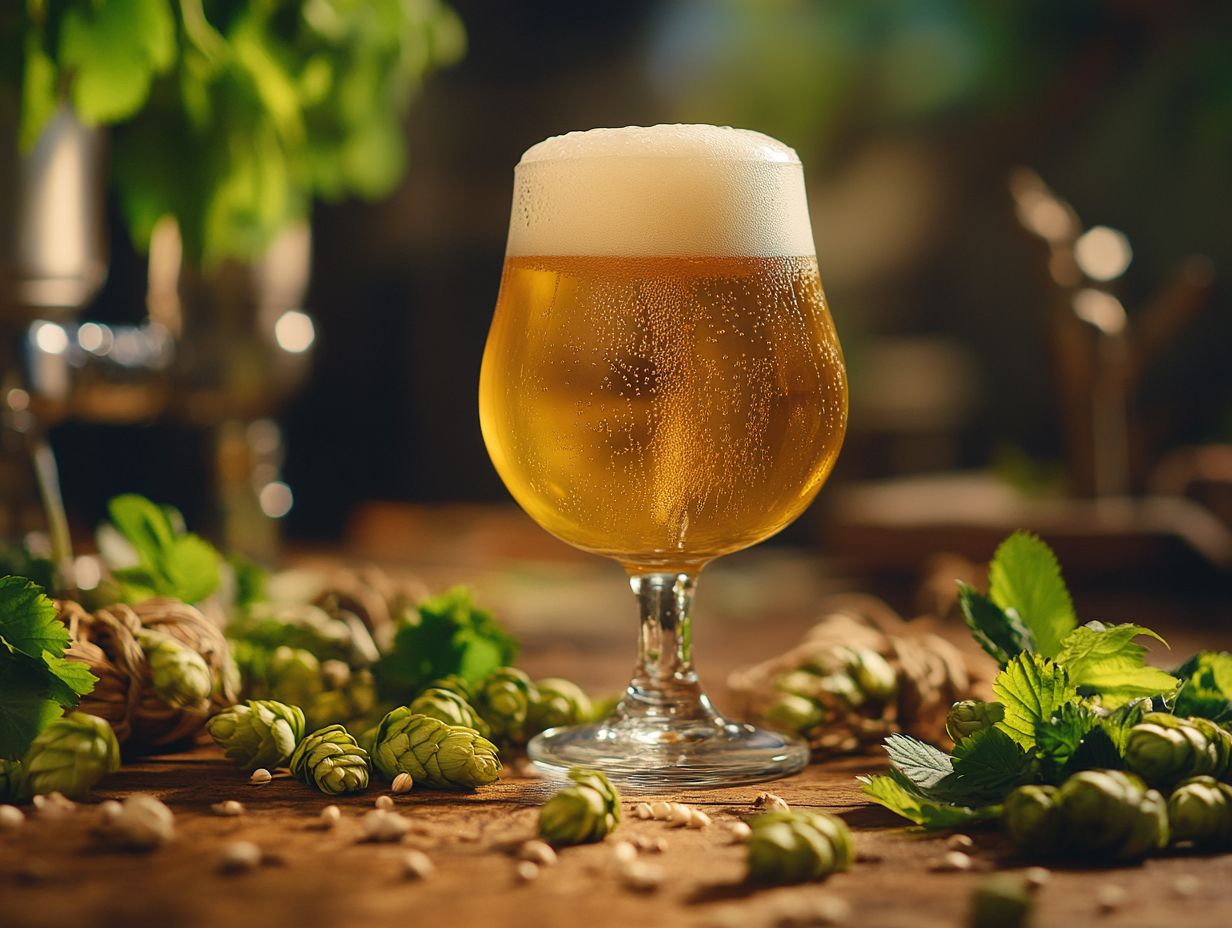
The fermentation process leads to the formation of esters and other flavor compounds that elevate the complexity of beer’s flavor profile. These compounds emerge from the interaction between yeast and sugars, along with other substrates in the wort, resulting in an impressive array of aromas.
These aromas span from fruity and floral to spicy and earthy. The wort composition, including proteins and other substances, can further influence the final flavor profile.
Esters are particularly noteworthy, as they impart sweet, fruit-like aromas reminiscent of bananas, apples, or pineapples. Get ready for a transformation in your tasting experience!
Flavor compounds like phenols add their unique characteristics as well, often bringing hints of clove or pepper to the table. The types of grains and malted barley used can also contribute distinctive flavors and aromas.
Together, these elements craft a multifaceted sensory experience that is essential for distinguishing between beer styles, ultimately enhancing your overall enjoyment of each brew.
What Is the Role of Fermentation in Craft Beer Culture?
Fermentation is at the heart of craft beer culture, where you, as a brewer, have the opportunity to experiment with unique fermentation processes and yeast strains. This creative exploration leads to the development of innovative beer styles that cater to a variety of palates.
By focusing on artisanal brewing techniques, you unlock a vast array of flavors and characteristics, ensuring that each craft beer becomes a singular experience. Embracing fermentation as an art form allows you to challenge the conventions of traditional beer production.
This approach introduces experimental and specialty beers that captivate beer enthusiasts around the globe. Integrating modern brewing methods with traditional practices can lead to innovative beer styles.
1. Importance of Unique Fermentation Processes in Craft Beer
Unique fermentation processes play an essential role in craft beer, enabling you, as a brewer, to innovate and create distinctive flavors that truly set your products apart from the sea of mass-produced beers.
By utilizing a variety of fermentation techniques ranging from traditional ale fermentation to cool fermentation for lagers, and even adventurous wild fermentation with spontaneous yeast you open the door to experimenting with an array of yeast strains and additional ingredients.
This approach not only enhances the complexity of flavors but also intricately contributes to the overall character of your beer. For instance, when you employ barrel-aging methods, you infuse your creations with unique woody notes.
Souring techniques introduce an exciting tartness that tantalizes the palate. The role of nitrogen and oxygen during fermentation can also impact the final product.
Each method you choose carries your signature, crafting a unique identity that resonates with beer enthusiasts and effectively differentiating your craft beers in a saturated market.
2. Influence of Fermentation on Beer Styles
Fermentation plays a significant role in shaping the diverse array of beer styles you can enjoy, as different yeast strains and fermentation conditions give rise to unique flavor profiles and aromas.
Take ales, for example; they use top-fermenting yeast, which typically results in fruity and complex characteristics. On the other hand, lagers, which rely on bottom-fermenting yeast, offer a cleaner and crisper taste profile that can be truly refreshing.
You might also notice brewers playing around with fermentation temperatures. When they opt for higher temperatures, it can amplify the esters and phenols in ales, creating delightful flavors reminiscent of banana or clove.
In contrast, cooler fermentation in lagers leads to a more restrained flavor profile, allowing the subtle malt and hop nuances to shine through. This fascinating interplay of yeast biology and environmental factors enables brewers to create distinctive beers.
Such as Belgian Tripels, celebrated for their spiciness, and Pilsners, renowned for their invigorating finish. The history of brewing science shows such methods have evolved significantly, contributing to the diverse beer styles we enjoy today.
3. Role of Fermentation in Creating Experimental and Specialty Beers
The role of fermentation in crafting experimental and specialty beers is significant.
It enables you as a brewer to explore unconventional ingredients and techniques, resulting in innovative flavors and styles.
By harnessing various fermentation processes, you can push the boundaries of traditional beer-making, uncovering a plethora of distinctive profiles. This exciting journey encourages you to add unique spices, fruits, and herbs, transforming ordinary brews into unforgettable experiences. Advancements in fermentation technology and microbiology have furthered these creative possibilities.
Introducing wild yeasts and barrel-aging techniques enhances complexity and depth of flavors. This invites you and other beer enthusiasts to embark on a captivating sensory journey.
As craft brewers like you continue to innovate, you challenge perceptions of what beer can be, making the brewing landscape more vibrant and diverse. This enriches the community’s appreciation for this art form. The historical significance of fermentation in ancient societies illustrates its enduring impact.
How Can Homebrewers Incorporate Fermentation Techniques into Their Beer?
You can elevate your homebrewing game by seamlessly incorporating fermentation techniques into your beer-making process. Experimenting with different yeast strains and fine-tuning fermentation conditions allows you to craft distinctive flavors and aromas that set your brews apart.
By mastering the basics of fermentation such as wort preparation (the liquid extracted from the malted grains before fermentation) and yeast management you can refine your brewing skills and explore a variety of beer styles.
The brewing process, including understanding bacterial impact and the role of fermentation in beer preservation, is crucial for developing your brewing knowledge. You can introduce fruits, spices, and other ingredients during fermentation to create innovative, personalized beers.
By introducing elements like citrus zests or seasonal spices, you can elevate the beer’s smell and complexity, enhancing the overall sensory experience. The timing of these additions can dramatically influence the final product; for example, adding fruit at various stages can impact both the flavor and fermentation activity, leading to delightful surprises.
This experimentation highlights the artistry of brewing, as you discover how distinct notes harmonize with one another, resulting in innovative brews that narrate a unique story with every sip.
1. Experimenting with Different Yeast Strains
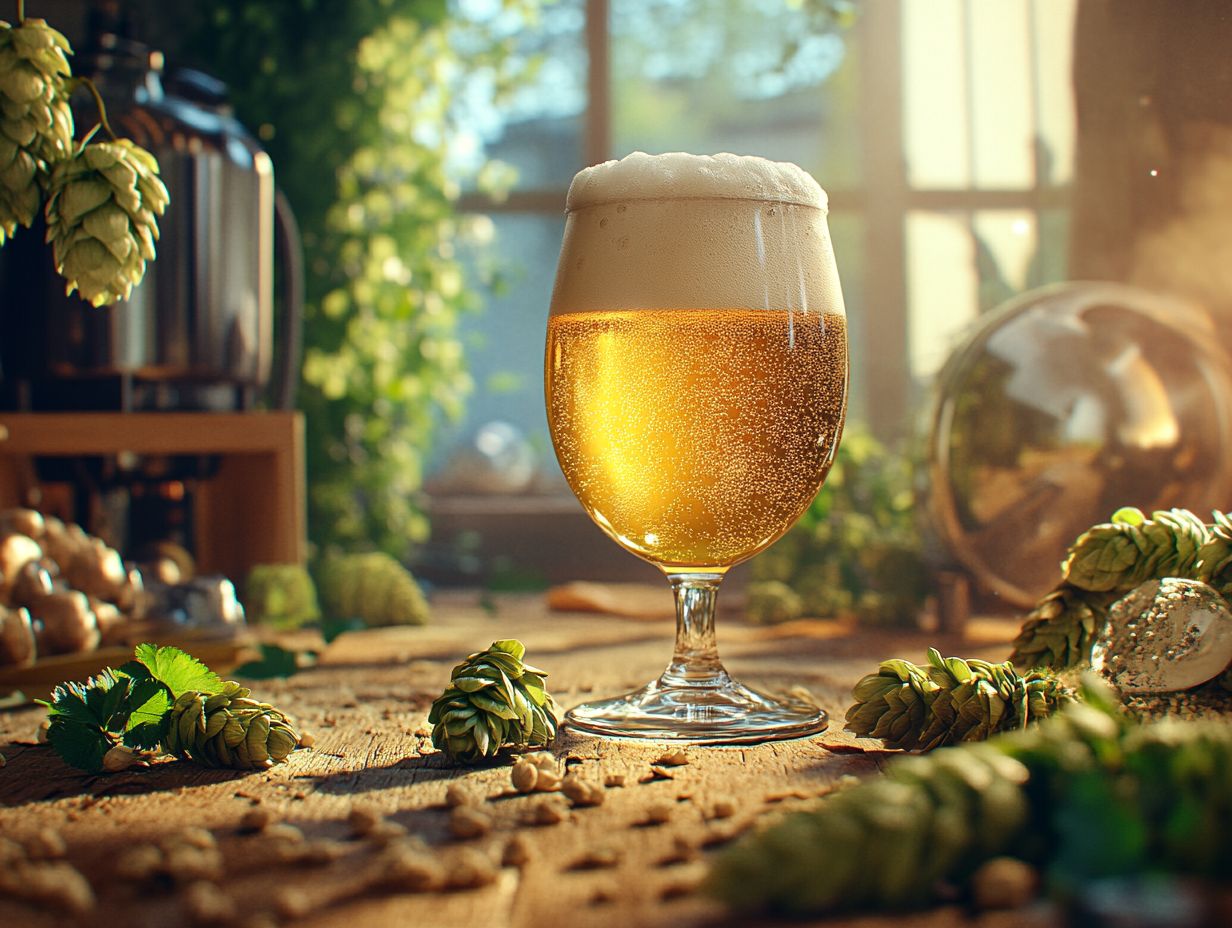
Experimenting with various yeast strains is essential for you as a homebrewer, as each strain brings its unique flavors and characteristics to your beer. This practice elevates the overall complexity of your brew and allows you to customize it according to your specific preferences.
For instance, the esteemed Saccharomyces cerevisiae, often utilized in ales, is renowned for producing fruity esters and a clean finish, making it a top choice among enthusiasts like yourself. On the other hand, lager yeasts such as Saccharomyces pastorianus deliver a crisper, cleaner flavor profile, perfect for those who appreciate more subtle and refreshing tastes.
The thoughtful selection of yeast strains can profoundly impact smell, mouthfeel, and overall flavor, highlighting its significance in the brewing process.
2. Adding Fruits, Spices, and Other Ingredients During Fermentation
Incorporating fruits, spices, and other ingredients during fermentation allows you, as a homebrewer, to explore a vast array of flavor profiles and craft unique, personalized beers. This creative journey unveils countless combinations and invites you to dive deeper into the fascinating science of fermentation.
The health benefits of certain fermentation methods can be an added bonus. By introducing elements like citrus zests or seasonal spices, you can elevate the beer’s smell and complexity, enhancing the overall sensory experience.
The timing of these additions can dramatically influence the final product; for example, adding fruit at various stages can impact both the flavor and fermentation activity, leading to delightful surprises. This experimentation highlights the artistry of brewing, as you discover how distinct notes harmonize with one another, resulting in innovative brews that narrate a unique story with every sip.
Frequently Asked Questions
What is fermentation and how does it play a role in craft beer culture?
Fermentation converts sugars into alcohol and carbon dioxide. It’s essential in craft beer culture, providing unique flavors and aromas that beer lovers cherish.
What are the different types of fermentation used in craft beer brewing?
There are two main types of fermentation: top-fermenting and bottom-fermenting. Top-fermenting yeast, a common type used in ales, differs from bottom-fermenting yeast found in lagers, resulting in distinct flavors.
How long does the fermentation process typically take in craft beer brewing?
The fermentation process can take anywhere from one week to several months. Ales generally ferment faster than lagers due to the yeast type and warmer temperatures involved.
What role does yeast play in fermentation and craft beer culture?
Yeast is crucial in fermentation, as it converts sugars to alcohol and produces carbon dioxide. Different yeast strains contribute unique flavors and aromas, making yeast a vital aspect of craft beer culture.
What factors can affect the fermentation process in craft beer brewing?
Many factors can influence fermentation, such as temperature, type of yeast, and sugar amount. Brewers must monitor these elements to ensure a successful fermentation.
What is the significance of fermentation and brewing methods in the overall taste of craft beer?
Fermentation is key to the taste and quality of craft beer. It shapes flavors, aromas, and alcohol content, leading to a balanced and complex flavor profile that defines the craft beer experience.

